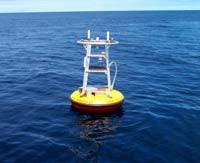Success for first ocean-wide simulation exercise to test tsunami warning systems in Indian Ocean
Paris, 16 October

- © Shoa/Valparaiso, Chile
- The Chilean oceanographic buoy, 280 miles off the coast of Iquique (Northern part of Chile). Tsunami warning system (depth : 4967 meters).
The first life-sized tsunami simulation exercise in the Indian Ocean was carried out successfully on 14 October, coinciding with World Disaster Reduction Day. The exercise aimed to test and evaluate the effectiveness of the Indian Ocean Tsunami Warning and Mitigation System (IOTWS), established in response to the tsunami of 26 December 2004, and to increase preparedness in the region.
More than 20 Member States from the Intergovernmental Coordination Group for the Indian Ocean Tsunami Warning and Mitigation System (ICG/IOTWS) participated in “Exercise IOWave09”. In the wake of the Samoa tsunami on 29 September, most of the participating countries were thus able to test the response capacity of their National Tsunami Warning Centre (NTWC) to bulletins issued by the Pacific Tsunami Warning Centre (PTWC) in Hawaii and the Japan Meteorogical Agency (JMA) in Tokyo.
Several countries, including Indonesia and Sri Lanka, conducted end-to-end tests on their warning systems, including evacuation drills at selected coastal communities. Regional Tsunami Watch Providers (RTWPs) in Australia, India and Indonesia exchanged bulletins during the exercise and shared these with their NTWC counterparts. This marked an important milestone for the IOTWS as the RTWPs are scheduled to take over regional advisory responsibilities from PTWC (Hawaii) and JMA (Tokyo) by early 2011.
The exercise started at 01.00 hours UTC (Coordinated Universal Time) and was completed by 13.00 hours UTC on 14 October. The exercise scenario replicated the magnitude 9.2 earthquake that occurred off the northwest coast of Sumatra (Indonesia) in 2004. Results will be evaluated over the next few weeks. Early feedback indicates that all bulletins were issued by the PTWC and JMA as scheduled. International observers in Indonesia have also reported that the exercise proceeded as planned at the Meteorological, Geophysical and Climatalogical Agency (BMKG) headquarters in Jakarta. In Aceh province, where evacuation drills were included, international observers noted that they were conducted successfully in accordance with the provincial standard operating procedures.
Australia indicated that the exercise was completed successfully, with good involvement of the federal and state emergency services; a few minor technical, training and procedural issues will be addressed in the near future. Kenya reported that the exercise “went perfectly” but highlighted the need for further training in emergency procedures.
The Intergovernmental Coordination Group for the Indian Ocean Tsunami Warning and Mitigation System (ICG/IOTWS) was established by UNESCO’s Intergovernmental Oceanographic Commission (IOC) in 2005, to promote exchange of seismic and sea level data for rapid tsunami detection, to provide warnings and to coordinate mitigation efforts among Member States. At the same time IOC began coordinating the creation of similar systems in the Caribbean (CARIBE-EWS) and the Mediterranean and Northeast Atlantic Ocean and connected Seas (NEAMTWS). The IOC has been coordinating the Pacific Tsunami Warning and Mitigation System (PTWS) since 1965.
- Author(s):UNESCOPRESS
- Source:UNESCO Press Release No. 2009 – 125
- 17-10-2009

